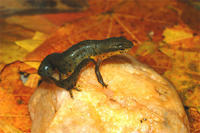EASTERN NEWT

The Eastern Newt is the only Kansas salamander to go through larvae, eft, and adult stages of development. Adults are aquatic preferring ponds, small lakes, marshes, and water-filled ditches. Larvae are also aquatic and live in small weedy pools. Efts are terrestrial, living under moist debris on the woodland flood.
Adults have a distinct yellow belly with small black dots while their head, body, limbs, and tail are olive-green to brown with small black dots.
Current probable range for the Eastern Newt in Kansas is restricted to lowlands within the lower Marais des Cygnes River basin, the Spring River basin, and the lower reach of the Neosho River basin within the Cherokee Plain Region of southeast Kansas.

Eastern Newts are protected by the Kansas Nongame and Endangered Species Conservation Act and administrative regulations applicable thereto. Any time an eligible project is proposed that will impact the species’ preferred habitats within its probable range, the sponsor must contact the Ecological Services Section, Kansas Department of Wildlife, Parks and Tourism, 512 SE 25th Ave., Pratt, Kansas 67124-8174. Department personnel can then advise the project sponsor on permit requirements.
DESIGNATED CRITICAL HABITATSAs defined by Kansas Administrative Regulations, critical habitats include those areas documented as currently supporting self-sustaining population(s) of any threatened or endangered species of wildlife as well as those areas determined by the Kansas Department of Wildlife, Parks and Tourism to be essential for the conservation of any threatened or endangered species of wildlife.
Currently, the following areas are considered critical for Eastern Newts:
All suitable wetlands, waters, and moist wooded bottomlands occurring within that portion of Cherokee County lying south and east of a line starting at the Kansas-Missouri border at Kansas Highway 96 in the SE 1/4 Sec. 12, T33S, R25E, then extending west along K-96 to its junction with Kansas Highway 26 at the NE corner Sec. 18, T33S, R25E, then south along K-26 to its junction with U.S. Highway 66 at SE corner Sec. 18, T34S, R25E, then south and west along U.S. 66 to the Kansas-Oklahoma border at Sec. 14, T35S, R24E. All suitable wetlands, water and moist wooded bottomland occurring within 5 air miles of the Marais des Cygnes Wildlife Area, Linn County.







